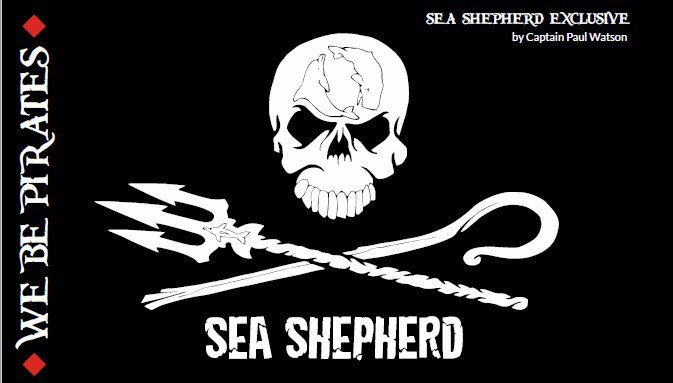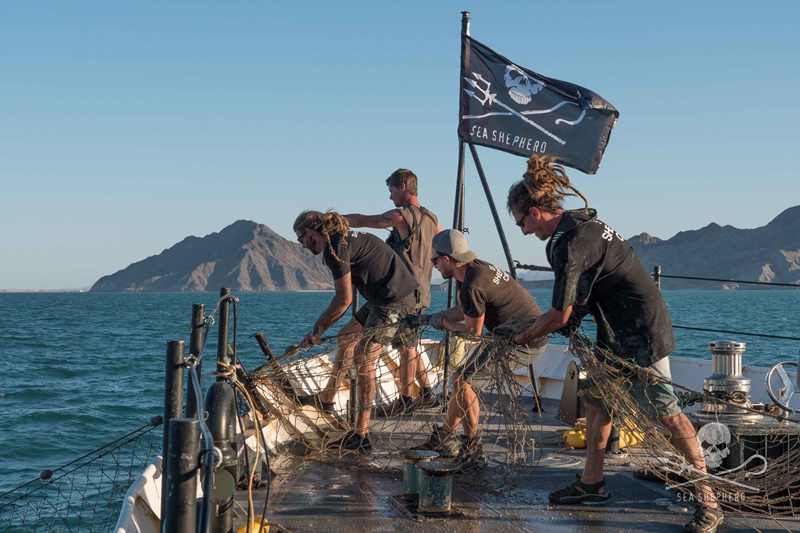I am often asked, “Why does Sea Shepherd use a Jolly Roger image for its logo?”
Aside from the fact that it’s super cool and kids love it, there are good reasons we sail under the black flag.
very historical pirate had its own individual flag. The white on black crossed cutlasses under the skull identified Captain Jack Rackham, for example. Originally, the flag was white or black on red, used by French pirates or privateers and it was referred to as the ‘jolie rouge’ meaning ‘the pretty red.” This was anglicized as ‘jolly roger,’ despite the evolution of the colors.
About two decades ago, our critics began to label Sea Shepherd as “pirates” in an effort to demonize us. I found it to be somewhat amusing, so we responded by saying, “If you want us to be pirates, well, we’ll be pirates.”
So, artist Geert Vons and I designed the Sea Shepherd version of the Jolly Roger. It was thoughtfully designed to convey our message. The black background represents the transformation of life into nothingness or extinction. The human skull conveys that we humans are the cause of the mass extinctions presently occurring. On the forehead of the skull is a yin/yang depiction of a dolphin and a whale. The yin and yang expresses our objective of ecological balance and the harmony of interdependence. The dolphin and whale represent the minds in the waters, and the key to that ecological balance is understanding the connections between species that maintain it. Below the skull is the crossed shepherd’s staff and the trident. The shepherd’s crook represents that we are protectors and defenders. The trident represents that our approach is aggressive, but crossed with the crook it means aggressive non-violence. The little dolphin on the trident signifies that our efforts are directed on behalf of our clients — the citizens of the sea.
In 2012, a U.S. federal judge declared that Sea Shepherd were pirates. However, he did not charge us with a crime nor did he present a case for our arrest. He labelled us pirates as justification for granting an injunction to a Japanese whaling fleet — the same fleet that the Australian federal court condemned for illegal whaling. It was an accusation without substance. Yet, what it meant is that, according to that judge, we had earned the right to call ourselves genuine bona fide pirates. The judge simply took sides as to which pirates he favored.
His accusation puts us up there with legendary pirates like John Paul Jones, Jean LaFitte, Sir Francis Drake, Sir Walter Raleigh, Sir Henry Morgan, Robert Surcouf, Edward Teach, William Avery, Jack Rackham, Anne Bonny and Mary Reid.
Now on the surface of this history. some of these men and women may appear to be villainous thieves and killers. But scratch the surface and there is a more complex history.
Some of these pirates were knighted by the British crown. Robert Sourcouf was presented with the Legion of Honour by Napoleon Bonaparte. John Paul Jones was a pirate and traitor to the British crown, but lionized as a hero to the Americans as the founder of the United States Navy. He was also the man that established the Russian Navy on behalf of Catherine the Great. As for myself, I was awarded the Amazon Peace Prize.
Pirates get things done. They cut through the red tape and they take action.
And of course, a pirate is a pirate depending on the perspective of his accusers. Just as the British condemned Jones as a pirate, the Spanish condemned Drake, Morgan and Raleigh as pirates. However, the gold that the British pirates took was simply gold that the conquistadores plundered from the Aztec and Incas.
The pirates of the Caribbean were simply stealing gold from the Spanish pirates who had stolen it from the people of Mexico and Peru. Stealing from the Dons was not theft, but more like a redistribution of illegally acquired wealth.
The pirates of the 17th and 18th century were men and women well ahead of their time in many ways. That was an era when the average seaman was no more than an expendable slave, to be flogged at the whim of his officers. They had very few rights and were subject to the mercy — or usually rather, lack of mercy — of their masters.
On a pirate ship, the crew voted for its captains. The captains and officers could be questioned and removed by a majority vote of people of all races working together in a democratic system. In fact, pirate societies were the first to give a vote to women, non-land owners and people of color.
Edward “Blackbeard” Teach would attack slavers and release the captives. He would give them a choice to be put ashore or to serve on his crew. If a black man chose to crew, he could rise through the ranks all the way to captain, based on skills and abilities alone.
Among the pirates there were no slaves, no oppressive class systems, no institutionalized racism, sexism or bigotry.
Women like Anne Bonny and Mary Reid sailed and fought with the men as equals. Anne Bonny remarked, when asked if she was concerned that the penalty for piracy was hanging, “And thank God for that, or else every fool and coward would be a pirate.”
In a time when young boys were hung for stealing bread in London, the rewards of piracy were far greater for an equal risk.
What piracy represented then was freedom. Freedom from the tyranny of a class society. Freedom from flogging, humiliation and servitude. These were things, then as now, that are worth taking risks for. Thus, pirates were identified with both freedom and romance and still hold a special place as such in the imagination of children.
Today the “pirates” of Somalia are in fact the victims of far more sinister pirates – the Asian and European fishing fleets that plundered Somalia’s fisheries and destroyed the underwater habitats along its coastlines.
And today the world is plagued by far more destructive pirates than ever existed before the 20th century. They include the vast pirate fishing fleets that are crewed in many cases by slaves, the smashing of coral and underwater fish habitats, the illegal slaughter of whales, the killing of seals, the massacre of dolphins.
Sir Henry Morgan demonstrated that the best way to stop piracy is to use pirates against pirates. History has shown that there are good pirates and bad pirates, and it takes good pirates to stop the bad.
And that is what Sea Shepherd does today. We are pirates driven by compassion to stop pirates motivated by greed. Thus, we pursue and stop outlaw whalers, pirate fishing operations and other illegal activities. In fact, Sea Shepherd is more of a pirate hunting movement than we are pirates, but that distinction rests in the eyes of either our supporters or our critics.
In 1814, pirate Jean LaFitte gave his support to Colonel Andrew Jackson in the defense of New Orleans from the British. During the American Civil War the Confederate raiders — called pirates by the Union — annihilated the Yankee whaling fleets and helped save three species of whales from extinction: the bowhead, the gray and the humpback.
Just as there is a saying that one man’s terrorist is another man’s freedom fighter, we can say that one person’s pirate is another person’s hero.
When I was a boy in eastern Canada, daydreaming at the end of the pier in St. Andrew’s-By-The-Sea on New Brunswick’s Passamaquoddy Bay, I envisioned myself as a pirate. That’s why having a federal judge actually canonize me as a real pirate was, I must confess, somewhat flattering. It was, somewhat, a realization of my childhood dreams.







